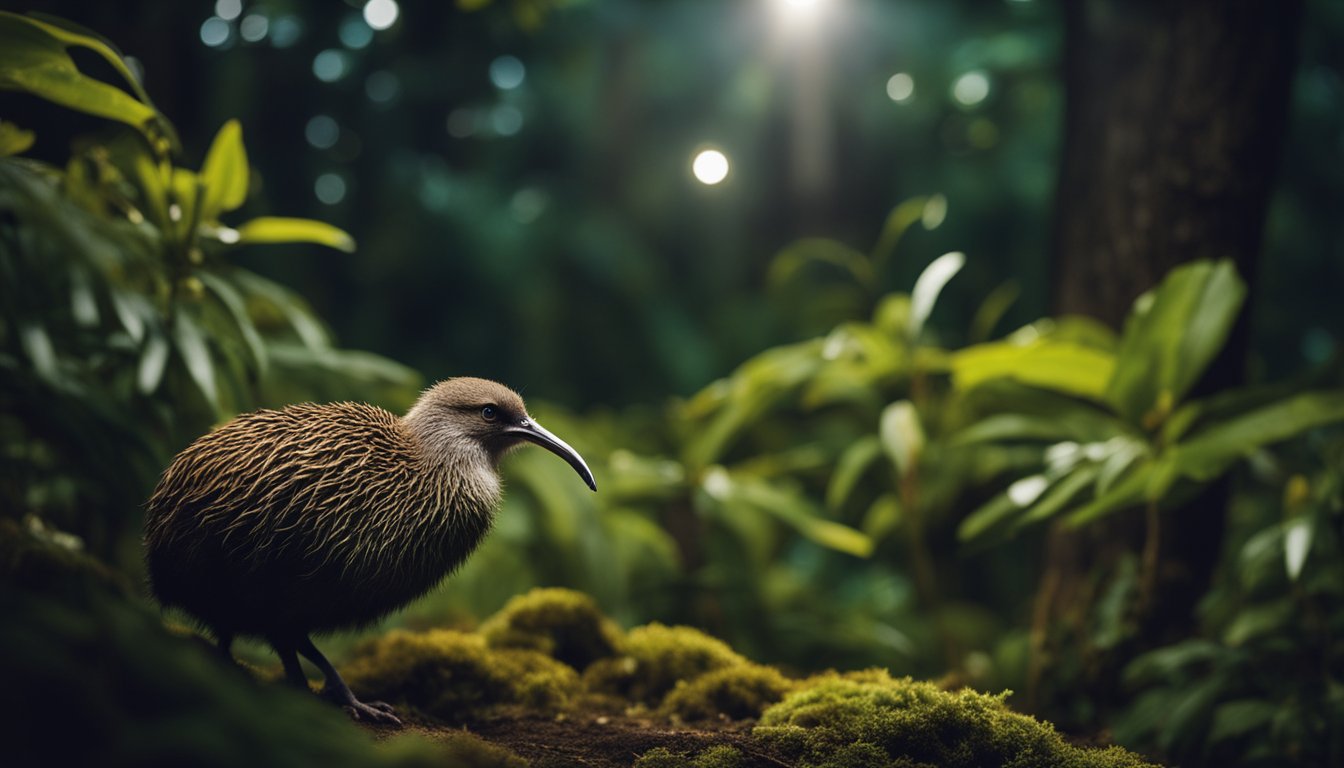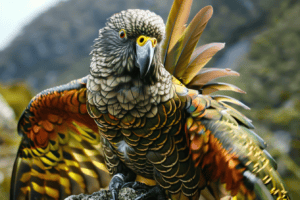Imagine us wandering through the dense forests of New Zealand after the sun sets.
The stars twinkle above as we stumble upon one of the country’s most extraordinary creatures, the kiwi bird.
These fluffy, peculiar birds are New Zealand’s hidden nighttime marvel, and they’re quite different from any other birds we might have seen.
With their round bodies, long beaks, and whisker-like feathers around their face, kiwis seem like characters straight out of a fairy tale.

Kiwis prefer the quiet of night to search for their dinner. Using their long beaks, they probe the earth for tasty morsels like insects and worms.
What’s fascinating is that kiwis have a great sense of smell, which is quite rare for a bird.
This helps them sniff out their food in the dark, underground labyrinth of the forest floor. Even more incredible is the size of their eggs!
Kiwi birds lay eggs that are almost as big as they are, making them quite the dedicated parents.
As we adventure through New Zealand’s magical nighttime world, it’s important we tread lightly and keep our voices down.
We wouldn’t want to miss a chance to spot a kiwi in its natural habitat.
These birds are shy and would rather keep to themselves, but if we’re lucky, we might just catch a glimpse of one.
So let’s keep our eyes peeled and our ears tuned to the soft rustling of the kiwi birds on the forest floor.
The Kiwi: New Zealand’s National Treasure

Imagine a cuddly bird with fluffy feathers that looks a bit like a kiwi fruit on legs – that’s our kiwi!
As the national bird of New Zealand, the kiwi is a true icon and quite the night owl, or should we say, night bird.
When we’re tucked into our beds, that’s when kiwis love to roam the forest.
Picture this: it’s nighttime in New Zealand’s wonderful wilds, and there’s a bird with a long beak, sniffing around like a detective.
That’s right, our kiwi’s beak is special because it has nostrils right at the end New Zealand Loves The Kiwi.
It’s like having a built-in super sniffer, which helps them find yummy bugs and berries in the dark.
Now, even though they have wings, kiwis can’t fly.
But what they lack in flight, they make up for with their strong legs, perfect for sprinting away from trouble.
Let’s not judge them too harshly for their no-flight status; after all, we can’t fly either!
Did you know kiwis lay enormous eggs?
We’re talking almost a fifth of momma kiwi’s body weight Interesting Facts About Kiwis.
Imagine carrying something that heavy! And since kiwis are quite shy, spotting one is like finding hidden treasure.
So let’s give a round of applause for our fuzzy little friends, the kiwis.
They may be flightless, but they soar high as a symbol of New Zealand, reminding us of the wonders that the night can bring.
Habitat and Lifestyle

In the velvety cloak of New Zealand’s nighttime, we find the kiwi, a remarkable bird that thrives in the darkness.
Let us explore the nooks and crannies of its life after dusk and the places it calls home.
Nightly Adventures
When the sun sets, it’s our kiwi friends’ time to shine.
Unlike most birds, they prefer sniffing around in the underbrush to soaring in the skies.
We navigate the forest floor with them, guided by their excellent sense of smell, as they rummage for insects and berries.
These little fellas sure have a big job every night, with just their nose and whisker-like feathers to lead the way!
Did you know kiwis lay eggs almost as big as themselves? Imagine carrying around something that hefty!
They lay the largest egg in relation to their body size of any bird species, so those nocturnal adventures also require a lot of rest.
While the rest of us cozy up in bed, the dedicated kiwi is busy maintaining their unique place in the ecosystem.
Homeland Habitats
If we peek into the lush forests and scrublands of New Zealand, particularly on the North Island, South Island, and Stewart Island, we’ll uncover the assorted dwellings of our kiwi pals.
The rowi and tokoeka, types of kiwi birds, have a preference for denser forests, often with a bit of elevation.
It’s like they choose the penthouses of the woodland world.
Some kiwis are so special that they only live in one spot! Take the rowi, for instance, preferring the comfort of the Okarito forest on the West Coast.
And let’s not forget about the tokoeka, with some choosing the alpine reaches of the Fiordland, and others sticking to the lower, grassy areas of Stewart Island.
So what ties all these habitats together?
It’s the kiwi’s need for thick vegetation that camouflages them during their nighttime escapades and provides safe dens for day-time snoozing.
The New Zealand terrain offers these hidden spots where our feathered friends can thrive away from the hustle and bustle of predators and human activity.
Perils and Protection

While we’re tucked in our beds at night, the kiwi birds are scurrying through New Zealand’s forests.
These unique birds face many dangers, but luckily, people are working hard to protect them. Let’s flap into the world of kiwi conservation!
Facing Threats
Imagine you’re a kiwi chick, just hatched and ready to explore. But wait—there are dangers lurking!
Predators like stoats, dogs, and cats might find you irresistible.
These introduced species can make a meal out of kiwi chicks before they even have a chance to grow.
It’s a hard knock life for our feathery friends, but it’s not all doom and gloom.
Kiwi birds once roamed freely without fear, but with these predators, they are at a constant risk of predation.
Conservation Crusade
Now, put on your superhero capes because the Conservation Crusade is here! Kiwi conservation is a big deal in New Zealand.
The Department of Conservation and various community groups are our heroes without capes.
They’ve created protected areas where our kiwi pals can waddle safely.
Did you know that on Stewart Island, kiwi birds are often seen in daylight?
This is thanks to fewer predators and the hard work of kind folks who want to keep them safe.
But the work doesn’t stop there; communities help by controlling their dogs, and conservationists are out there setting traps to catch those pesky stoats.
The aim is to give kiwi chicks the chance to grow up and dance in the wilderness just like they’re meant to.
Through these conservation efforts, the kiwi’s distinctive nighttime cries continue to echo across New Zealand’s wild spaces, and we’re all pitching in to make sure it stays that way.
Understanding Kiwis

Let’s embark on an exciting journey into the world of New Zealand’s most beloved birds—kiwis!
From their distinct physical traits to their unique way of bringing new life into the world, we’ll discover why these flightless wonders are nothing short of remarkable.
Physical Features
Have you ever wondered what makes kiwi birds so special?
Well, for starters, kiwi are flightless birds, which means their wings are so small they’re almost invisible!
Our feathered friends come in five species: the brown kiwi, great spotted kiwi, little spotted kiwi, southern brown kiwi, and the tokoeka.
Each species has its own unique flair, but what they all share is a soft, hair-like plumage that makes them look quite fuzzy and cuddly.
Kiwi also boast a long, slender bill that’s not just for looks—it’s packed with sensory pits that help them sniff out dinner, like a hidden game of hide and seek.
When they’re sniffing their way through the dark, they’re using those whisker-like features to find snacks beneath the forest floor.
Reproduction and Growth
Now, let’s talk about how kiwi keep their families growing! Kiwi’s breeding habits are as fascinating as they are.
Did you know that the kiwi egg is one of the largest egg-to-body weight ratios of any bird?
Imagine a chicken laying an egg the size of a melon—seems pretty wacky, right?
Once these oversized eggs are safely tucked into a burrow, the male kiwi takes on the role of super dad, incubating them for up to 80 days.
That’s patience! When the chicks finally make their grand entrance, they’re not your typical needy babies.
Nope, kiwi chicks are born ready to rock and roll, fully feathered and independent. Talk about being born with confidence!
As for their growth, Kiwi grow slowly and can live pretty long lives compared to other birds, with some enjoying the forests for up to 50 years.
Watching a kiwi grow is like watching a young explorer come into their own, ready to tackle the wilds of New Zealand.
Frequently Asked Questions
Let’s dive into some of the most twinkling questions about the kiwi birds that turn New Zealand’s nights into a feathered festivity!
Who are the stars of the night in ‘Kiwi Bird Wonders: New Zealand’s Nighttime Marvel’?
When the sun dips down, the kiwi birds step into the spotlight.
They’re the real superstars, captivating us with their nocturnal antics and ground-prowling performances under the moon’s glow.
What makes the kiwi New Zealand’s special feathered friend?
Our kiwi mates are special for a bunch of reasons!
From their hair-like feathers to the unique placement of their nostrils at the end of their beak, they’re New Zealand’s living treasures and a true symbol of the wild wonders these islands hold.
How many kiwi birds can we still whisper goodnight to in the wild?
There’s a precious number of around 68,000 kiwi birds remaining in the wild.
But let’s keep our voices down because every snooze helps these shy creatures keep grooving through the night!
When’s the perfect time to tiptoe into the forest to spy on kiwi birds?
To catch a glimpse of these night-time marvels, we need to wait until the forest is just a whisper, usually after nightfall and throughout the evening.
That’s their prime time for rustling through the undergrowth and showing off their moonlit moves.
Do kiwi birds have special goggles for seeing in the dark?
While they don’t wear goggles, kiwi birds do have some pretty nifty built-in adaptations.
Their eyes, fine-tuned for nighttime vision, help them navigate the dusky underbrush where they reign as nocturnal royalty.
What kind of nighttime shenanigans do kiwi birds get up to in the twilight?
These quirky birds are the monarchs of mischief after dark, using their keen sense of smell to forage for a smorgasbord of insects and other invertebrates.
They’re proficient food finders and love a good night-time feast in the forest.










Add Comment